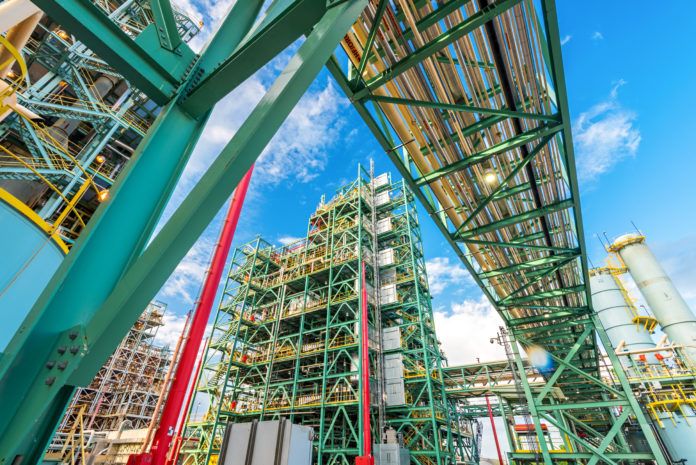Innovative products manufactured at Honeywell plants in Louisiana are having a global impact—not only on a wide range of industries, but also on the environment.
Honeywell held a ribbon-cutting in May as it kicked off commercial operations at a manufacturing plant in Geismar that will meet the growing global demand for a new mobile air conditioning refrigerant. With the startup, the plant in Ascension Parish has become the world’s largest site for producing HFO-1234yf, sold commercially as Solstice® yf.
Based on next-generation hydrofluoro-olefin technology, Solstice yf was developed by Honeywell scientists to meet the needs of the automotive industry to replace R-134a, the most widely used auto refrigerant. Solstice yf has a global-warming-potential (GWP) of less than 1, which is lower than carbon dioxide and 99.9% lower than R-134a, which has a GWP of 1300. R-134a is a hydrofluorocarbon (HFC), which many governments and industries have been looking at phasing out since the early 2000s.
“Solstice yf is a breakthrough innovation that is helping the auto industry transition to more environmentally preferable technologies without sacrificing performance,” said Ken Gayer, vice president and general manager of Honeywell Fluorine Products. “Honeywell invested significantly in research and development for more than a decade to enable our award-winning scientists to create new, near drop-in alternatives to meet the rising demand to replace HFCs.”
REDUCING EMISSIONS
Already, more than 28 million cars on the road use Solstice yf, a number that Honeywell expects to surpass 40 million by the end of 2017. Nearly every carmaker in the auto industry plans to use the refrigerant in at least one of their U.S. models. Global adoption of the refrigerant will reduce greenhouse gas emissions by the equivalent of permanently removing more than 30 million cars from the road, Honeywell says. The Honeywell development team, led by Rajiv Singh, won the prestigious Heroes of Chemistry Award from the American Chemical Society for the product.
Honeywell’s Geismar facility has increased its workforce by more than 20% to staff the Solstice production operation, with 260 full-time employees now working at the site. Construction on the new plant began in 2015 and supported nearly 1,400 construction jobs. The state-of-the-art plant will serve as the showcase for some of Honeywell’s own process and automation technologies, including Honeywell Connected Plant and the Experion Orion Console, the automation software that runs the Solstice yf production line.
FOAM WITHOUT HFC
Meanwhile, a Solstice sister product manufactured at Honeywell’s Baton Rouge plant is being adopted for use in products ranging from chair armrests to shoe soles to home insulation. Honeywell’s Solstice Liquid Blowing Agent (LBA) was developed as an ultra-low-GWP replacement for a range of HFC blowing agents that are being phased out by the Environmental Protection Agency.
Dow selected Solstice LBA last year for use in new foam systems it developed to make integral skin, or I-Skin, foam. Blowing agents are critical for foam systems because they cause the foam to expand properly, significantly impact the foam’s performance and make it easier to manufacture. But the use of HFC blowing agents in I-Skin polyurethane foam applications was banned in the U.S. as of Jan. 1, so Dow collaborated with Honeywell and Air Products, which makes catalysts designed specifically to work with Solstice LBA, to develop its new systems without HFCs.
Honeywell’s Solstice LBA world-scale manufacturing plant in Baton Rouge started up in June 2014 with two production trains. The facility has 160 employees.
“The result of our collaboration is best-in-class, HFC-free, I-Skin systems that meet our high performance standards in advance of impending environmental regulations,” said Scott Snyder, Dow marketing manager, last year. “Our new I-Skin systems will give our customers a competitive advantage, as well as improve the sustainability profile of their products.”
Tests of Dow’s new polyurethane solutions, VORALUX™ for furniture and SPECFLEX™ for custom molding, demonstrated superior results for a variety of Shore A hardness levels, a critical quality measure, Honeywell says.
Solstice LBA is used in a variety of rigid foam insulation applications, including residential and commercial refrigeration equipment, spray foam insulation and insulated metal panels, as well as flexible foam applications, such as molded and slabstock foam, and I-skin. I-skin becomes part of products such as office furniture armrests, molded seat pads, shoe soles and many other products that require cushioning properties and a durable surface—even padded cushions for rollercoasters.
ROOFING AND WALLS
NCFI Polyurethanes, a leading maker of sustainable polyurethane products, has also shifted to Solstice LBA for its I-skin applications, as well as for roofing applications, with wall insulation systems expected to follow.
The adoption of Solstice LBA is part of how NCFI is fulfilling its commitment to reduce greenhouse gas emissions that was first publicized during an exclusive 20-company roundtable discussion held at the White House in October 2015. At that event, NCFI was honored for its proactive plans to transition from HFCs to low-GWP products. Honeywell was also recognized at the event.
Compared to NCFI’s HFC-based insulation systems, the new systems featuring Solstice LBA deliver improvements in sprayability, consistency and surface finish, according to Honeywell. The foam is also stronger, which allows for walking on the roof to maintain equipment with less risk of damaging the foam.
And in April, Demilec, one of North America’s largest manufacturers of spray foam insulation, introduced a new product also formulated with Solstice LBA. The company’s Heatlok® HFO High Lift spray foam insulation system is for use in commercial and residential wall insulation.
“We are seeing growing acceptance of spray foam by architects, builders, and homeowners,” said Demilec President Paul Valle. “They recognize the value of a well-sealed building insulated with spray foam. I think Solstice LBA will become a key differentiator as people demand a more comfortable living space with greater energy efficiency.”
From the innovative chemistry to the major impact on a range of industries, Honeywell’s Louisiana workers are making some pretty cool stuff these days—not to mention helping all those drivers cool down their cars.
This article was originally published in the third quarter 2017 edition of 10/12 Industry Report.









